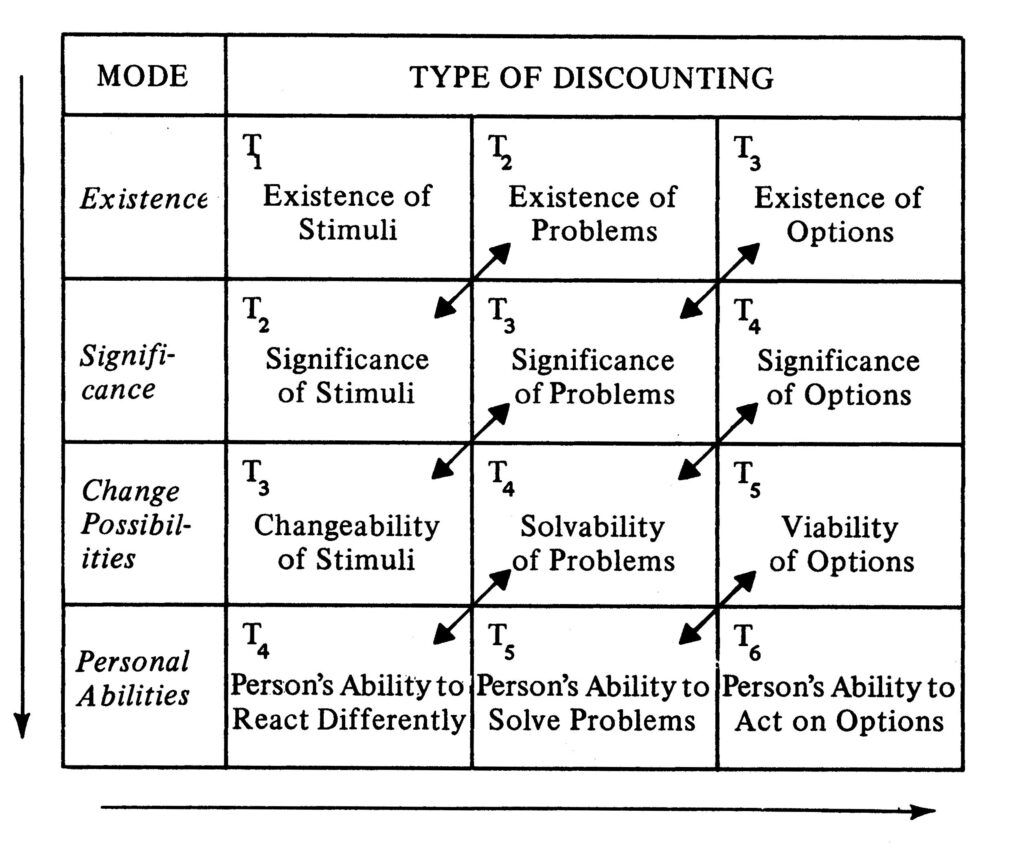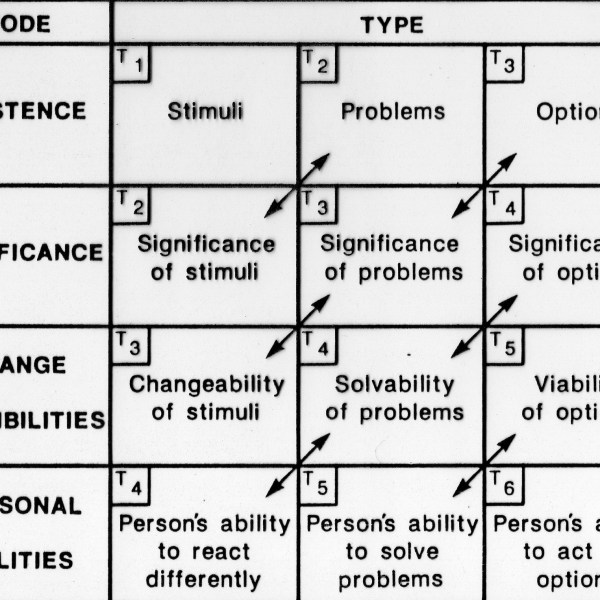Tricky looking picture, eh! Feel free to avoid it at this time if it brings forth a human tendency to disconnect from the uncomfortable things in our lives. Timing and pace are two key features in the change process. My advice is to rush nothing, if possible.
My editing ‘skills’ have not helped, but I’m not altering the picture at this time, as it really needs taking apart for it to make sense.
This is what I will do for the rest of this page. Please stick with it as I explain. In my experience, the Discount Matrix really can help, even if it’s a little indigestible.
PUTTING THINGS INTO BOXES
Therapy and medicine are rather fond of understanding life problems by putting them into boxes. This is the world of diagnosis. I will introduce one ‘diagnostic’ tool that I have found helpful.
There are others but I put The Discount Matrix in to assist you with the design of rather more complex safe experiments. This tool, here in all its glory, is called:
THE DISCOUNT MATRIX

My diagram is taken from page 16 of Transactional Analysis: Treatment of Psychosis by Jacqui Lee Schiff and others (1975).
Now you can see why I left this out of my web site for some time. Actually, it may be simpler to manage than it looks, so let’s do that!
THE ‘HIERARCHY’ OF DISCOUNTING BEHAVIOURS
If you want, make a connection between this chart and the Johari Window. In that Window, our scenic routes go from top left to bottom right – from the known into the unknown.
In the Discount Matrix, our scenic route is from the bottom right to top left;
- from the ‘easiest’ bit – things that are within our reach;
- to the hardest bit, when we do not accept there is a problem at all. Any ‘problem’ can be so ‘not there’ that we dissociate from it. That is one way to disconnect so completely from the ‘inconvenient’ things in our lives.
- that ‘top’ line presents a large problem that is labelled a ‘double bind’ way down in this hyperlinked page. How do humans best find out what they need to know, but do not know, and often refuse to see?
In the Discount Matrix, we are being invited to consider:
1. our available choices, and act on them in an ordered or systematic way. Think about the THINK-MAKE OPTIONS-JUDGE-ACT experiment here.
2. devising experiments to help remove any blocks to solving those problems?
3. being able to admit our inability to see an obstacle at all. Are there ways we can help ourselves move things on when something appears in plain sight to others?
4. reacting differently, or does history have to go on repeating itself.
TURNING THIS INTO ACTUAL EXPERIMENTS
Each hyperlinked page has some safe experiments – many of the ‘basic’ experiments are often worth revisiting. Here, I put some others in a different light.
Consider this line of inquiry: do you agree with the idea that we have issues, problems or obstacles in our lives – ones that we simply do not know about?!
If you can agree with that, read on. If that belief does not hold water for you, leave this page and do something else, instead; maybe revisit the scenic route. Here’s me being directive for once, but I cannot think of anything else to say!
Why? Because I am alleging you are operating at the highest level of discount, without any evidence, and you do not agree. That is your right and then there is the question: whose right?
It’s fine for us to disagree and it only remains to decide what to do instead.
I see no ships
So what is this highest level of discount? ‘I see no ships’, is a phrase (wrongly?)attributed to Admiral Nelson (good ole Norfolk boy). He is supposed to have said this when he covered his ‘good’ eye, just before the sea battle of Copenhagen, against the Spanish fleet.
This ability to “see no ships” is well suited to the top left box; if something is not seen, it does not exist (unless you want a philosophical argument about the point!).
You cannot experiment on that one, when you see no need to do so. Just press on regardless – and, indeed, Nelson obtained a large victory from his stubbornness.
So, instead, let’s travel to the more actionable box in the bottom right.
An experiment using the Discount Matrix
Think of a simple problem in your life today. Nothing too threatening; maybe a communications issue with some-one. One in which you are confident you can react differently.
That is:
- you have the ability to be flexible, and
- you want to change, and
- you are willing to try out something new, and
- you have the ability, in yourself, to solve problems.
BUT can you see your choices (options)?
This can be the level of discounting most easily addressed. It only requires you to identify what your options are – a lot of experiments on this website focus on generating your choices or options.
A starting experiment
The concern here is focused on our abilities to find a change that is needed.
So: remind yourself about that issue. Have you written it down in the shortest possible form?
How would you prefer it to be NOW. Get that written down.
List three ways you might get from here to there. You could write down more, but three is a handy number of options to get started.
Spend time looking at your list of three or more. What needs to be done to move one of them on; just one of them.
You may well notice that one is easier to pursue, than the others.
Start with the easiest and, as you experiment, you will discover that you develop further options and, indeed, you may be able to address them one at a time – from the one you find easiest, to ones you find more tricky.
That’s an experiment focused on your PERSONAL ABILITIES to change – the four boxes at the bottom of my diagram.
Let’s try another example using the middle boxes
The next line up, starting T3. is about SOLVABILITY and CHANGE POSSIBILITIES.
This line assumes you can see a problem, but it does not assume you have the personal ability to generate a needed change.
In this example, experiment by writing down an issue, and some notes on why it is an issue for you now.
Ask yourself: what’s stopping me getting grips with some of the whys and wherefores of this issue. Just write down all and everything – anything that comes into your head. This process is called Free Association and Freud was rather fond of it as a safe experiment (not that he called it such).
On this occasion, I rather hope there will be a longer list.
When you’ve done all that you can, take a break and come back to your list when you are more refreshed. Work on each item bit-by-bit in an ordered and systematic way.
Has the passing of time enabled you to look at things differently? Has it let you see the possibility of change and, if you are lucky, find some way in which the issue might be solved?
For example, do you notice how your motivation can flag and, if so, how might the energy to foster change be found and corralled?
Now it gets trickier
The next higher level of discount (starting T2) – at the level of significance – is not so easy to address. Outsiders are often needed to make changes here.
In my first career – in the probation service – it was often me who played that part, with varying degrees of success. Plainly, the police serve a similar function. Partners who are successful at putting their foot down may be able to create change.
Sadly, those behaviours are too often discounted by us and we become unwilling to act. I saw people go to prison for holding their hand over the ‘good’ eye. They did not win the battle, unlike Nelson.
Often these higher level of discounting are addressed only in the face of a crisis that brings things to a head.
All the experiments I have mentioned about relaxation, mindfulness and spiritual self, including the Safe Place experiment can help. Each one contributes to helping you address aspects of our tendency to discount problems in our lives. In a relaxed state we may be more able to see what is there before us. Mindfulness can broaden our minds so our minds are not too full!
I have spoken a lot about relaxation and I hope your experiments have helped you become more aware of what gets in the way of your own personal development.
As our inability to let go of cherished beliefs is an issue for most of us, you may find this audio material, or podcast, of interest. If you use it, please concentrate on the task and beware of multi-tasking alongside it! Do not use this material when doing risky things, such as driving. See my tape at:
https://anchor.fm/robintrewartha/episodes/Floating-Back-e1la22t
Because I am a Spotify man, it is on that app somewhere – using SEARCH of my name on your Spotify account should help you find this material.
Some other leads and return trips
Designing a small safe experiment
